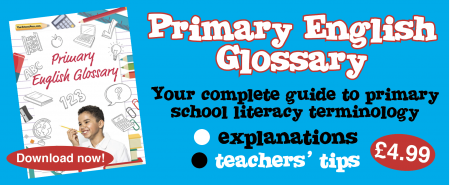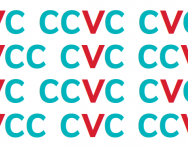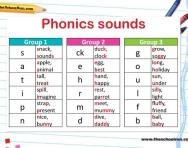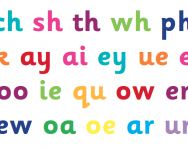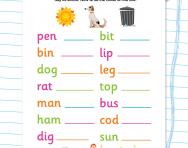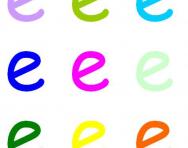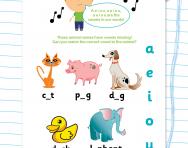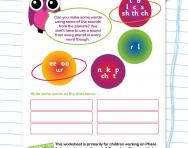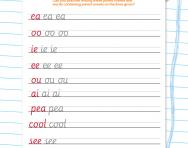What are vowels and consonants?
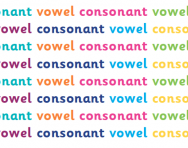
What are vowels and consonants?
The alphabet is made up of 26 letters, 5 of which are vowels (a, e, i, o, u) and the rest of which are consonants.
A vowel is a sound that is made by allowing breath to flow out of the mouth, without closing any part of the mouth or throat.
A consonant is a sound that is made by blocking air from flowing out of the mouth with the teeth, tongue, lips or palate ('b' is made by putting your lips together, 'l' is made by touching your palate with your tongue).
The letter 'y' makes a consonant sound when at the beginning of a word ('yacht', 'yellow') but a vowel sound when at the end of a word ('sunny', 'baby').


Watch your child's grammar confidence grow
- Perfect Punctuation Workbook
- Grammar Games Pack
- PLUS 100s of other grammar resources
Vowels and consonants in primary school
Children learn all the letters of the alphabet in the Foundation Stage (nursery and Reception years). This means they learn to look at a letter and then make its sound, but also to hear the sound of a letter and be able to write it down.
In Reception children move onto learning to read and write CVC words (consonant, vowel, consonant) such as cat, top, hit, nap.
They then move on to read and write CCVC words such as trip, stop, pram.
They also learn CVCC words such as milk, lamp, tusk.
Children will also learn that sometimes two vowels are put together to make one sound, such as ai, oo, ea, ie which can be found in words such as rain, boot, read and pie. When two vowels are put together to make one sound, this is called a vowel digraph.
They also learn that sometimes two consonants are put together to make one sound, such as th, ch and sh which can be found in words such as bath, chip and mash. When two consonants are put together to make one sound, this is called a consonant digraph.
Teachers may or may not make children aware of all the linguistic vocabulary in bold above. It is not necessarily important that they know these words or can define them: the most important thing is that they learn to read and write individual letters and words with confidence through thorough step-by-step phonics activities.
Children moving up the school may notice certain things about vowels and consonants. For example, in English we rarely have three or more vowels together; beautiful, queue, liaise, quail, quiet, squeal are some of the few words that use this spelling pattern.
Another thing children may notice is that every word in the English language contains a vowel. This is quite a useful thing to know when playing hangman: go for the vowels first!
Vowels and consonants FAQS
Q: What are vowels and consonants?
- Vowels and consonants are the two main types of letters in the alphabet. Vowels are the letters A, E, I, O, U, and sometimes Y, which produce open sounds when pronounced. Consonants are all the other letters of the alphabet, which produce closed or partially closed sounds when pronounced.
Q: How can I help my child recognise vowels and consonants?
- You can help your child recognise vowels and consonants by engaging in activities such as playing word games, using flashcards, and reading together. Encourage them to identify vowels and consonants in words they encounter in books, signs, and everyday objects.
Q: Why are vowels and consonants important in learning to read and write?
- Vowels and consonants are essential in learning to read and write because they form the building blocks of words. Understanding the distinction between vowels and consonants helps children decode words, spell correctly, and develop fluency in reading and writing.
Q: What are some common examples of vowels and consonants?
- Common examples of vowels include A, E, I, O, U, and sometimes Y. Examples of consonants include B, C, D, F, G, H, J, K, L, M, N, P, Q, R, S, T, V, W, X, and Z.
Q: How can I help my child with vowel and consonant sounds?
- You can help your child with vowel and consonant sounds by practicing pronunciation together. Use phonics exercises, rhymes, and songs to reinforce the sounds of vowels and consonants. Reading aloud to your child regularly can also help them become familiar with different vowel and consonant sounds.
Q: What if my child struggles with identifying vowels and consonants?
- If your child is having difficulty identifying vowels and consonants, try breaking down the concepts into smaller, more manageable parts. Use multisensory approaches, such as visual aids, auditory cues, and hands-on activities, to reinforce learning. If concerns persist, consider consulting with your child's teacher or a literacy specialist for additional support and guidance.

Give your child a headstart
- FREE articles & expert information
- FREE resources & activities
- FREE homework help
